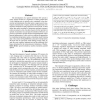Free Online Productivity Tools
i2Speak
i2Symbol
i2OCR
iTex2Img
iWeb2Print
iWeb2Shot
i2Type
iPdf2Split
iPdf2Merge
i2Bopomofo
i2Arabic
i2Style
i2Image
i2PDF
iLatex2Rtf
Sci2ools
INTERSPEECH
2010
2010
Rapid development of speech translation using consecutive interpretation
The development of a speech translation (ST) system is costly, largely because it is expensive to collect parallel data. A new language pair is typically only considered in the aftermath of an international crisis that incurs a major need of crosslingual communication. Urgency justifies the deployment of interpreters while data is being collected. In recent work, we have shown that audio recordings of interpreter-mediated communication can present a low-cost data resource for the rapid development of automatic text and speech translation. However, our previous experiments remain limited to English/Spanish simultaneous interpretation. In this work, we examine our approaches for exploiting interpretation audio as translation model training data in the context of English/Pashto consecutive interpretation. We show that our previously made findings remain valid, despite the more complex language pair and the additional challenges introduced by the strong resource-limitations of Pashto.
INTERSPEECH 2010 | Language Pair | Low-cost Data Resource | Signal Processing | Speech Translation |
| Added | 19 May 2011 |
| Updated | 19 May 2011 |
| Type | Journal |
| Year | 2010 |
| Where | INTERSPEECH |
| Authors | Matthias Paulik, Alex Waibel |
Comments (0)

